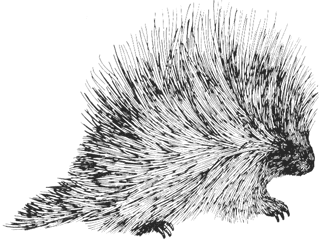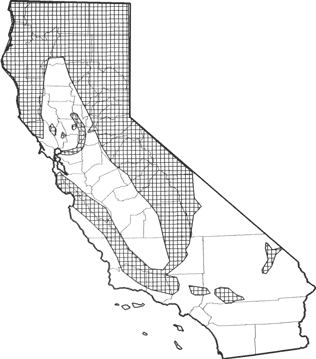
Common Porcupine
Distribution, Abundance, and Seasonality
The common porcupine is found throughout the Sierra Nevada and Cascades from Kern Co. north to the Oregon border, south in the Coast Ranges to Sonoma Co., and from San Mateo Co. south to Los Angeles Co. Scattered populations occur in wooded habitats throughout the Central Valley (Laurendine et al. 1996), as well as Los Angeles and San Bernardino counties. Common to fairly common throughout its range, but populations tend to be localized. Most common in montane conifer, Douglas-fir, alpine dwarf-shrub, and wet meadow habitats. Less common in hardwood, hardwood-conifer, montane and valley-foothill riparian, aspen, pinyon-juniper, low sage, sagebrush, and bitterbrush (Taylor 1935, Woods 1973, Dodge 1982).

Range Map
Specific Habitat Requirements
Feeding: In spring and summer, feeds on aquatic and terrestrial herbs, shrubs, fruits, leaves, and buds. Winter diet consists of twigs, bark, and cambium of trees, particularly conifers, and evergreen leaves. Trees utilized include yellow pines, Douglas-fir, pinyon pine, lodgepole pine, western white pine, limber pine, bristle-cone pine, firs, oaks, maple, cottonwood, willow, and elderberry. Utilizes fecal fermentation and has an enlarged liver, adaptations which may be related to a winter diet low in vitamins. Porcupine damage to forest trees usually is localized, and is reviewed by Woods (1973) and Dodge (1982).
Cover: Uses caves, large rock crevices, hollow logs, trees for cover (Taylor 1935, Woods 1973).
Reproduction: Dens in caves, crevices in rocks, cliffs, hollow logs, snags, burrows of other animals; will use dense foliage in trees if other sites are unavailable (Taylor 1935, Woods 1973, Thomas 1979).
Water: Probably must drink.
Pattern: Requires forest with a good understory of herbs, grasses, and shrubs (Taylor 1935, Woods 1973). Prefers open stands of conifers. In spring and summer, uses meadows, brushy and riparian habitats for feeding. In winter, restricted to forests. In relatively arid regions, somewhat restricted to riparian habitats.
Species Life History
Activity Patterns: Active yearlong, primarily nocturnal but often active in daylight. Does not hibernate, but body temperature may drop 5Á C (9Á F) in extreme cold. During such times, may restrict activities to a single tree, or hole in a rocky area. Rarely active below -18ÁC (-1ÁF) (Taylor 1935, Dodge 1967, Woods 1973).
Seasonal Movements / Migration: Makes local migrations between habitats that are used in summer and forests that are used in winter. Some mass movements have been reported (Woods 1973).
Home Range: Home range varies from a few to over 100 ha (250 ac). Summer home ranges are larger than winter ranges. Winter home ranges in New York averaged 5.4 ha (13.5 ac) (Shapiro 1949). Summer home range in Minnesota averaged 14 ha (35 ac) (Marshall et al. 1962). In Oregon, moved further in April-July than in December-February; 2 females had a yearly home range of 70.1 ha (175 ac) (Smith 1979). Densities reported up to 10/km? (26/mi?) (Woods 1973), and are variable, depending on habitat suitability, predation, and phase of population cycle. Peaks in density occur every 12-20 yr.
Territory: Does not defend a territory, but males may fight over estrous females. Winter feeding trees are sometimes defended, but porcupines may winter together as well (Woods 1973, Dodge 1982).
Reproduction: Mates in fall or winter. Gestation is nearly 7 mo. Births usually take place from April through May, but may occur from February through June. There is a single litter of 1, with a few possible instances of twins (Dodge 1982). Females are seasonally polyestrous, recycling every 25-30 days if fertilization does not occur (Woods 1973). The precocial young are capable of climbing and assuming a defensive posture soon after birth, and can survive on a diet of vegetation by 2 wk of age. Lactation, however, may continue to September. Infant mortality is low. Females are sexually mature as yearlings, and reproduce for the remainder of their lives, which may be up to 10 yr (Taylor 1935, Woods 1973, Dodge 1982).
Niche: This well-defended herbivore is preyed upon by mountain lions, bobcats, wolverines, and fishers (Taylor 1935, Woods 1973). Fishers, in particular, are effective predators of porcupines, and control porcupine density in some areas (Powell and Brander 1977). In Texas, host to the chewing louse Eutrichophilus setosus (Wilson and Oliver 1979).
Sources & References
California Department of Fish and Game, 1999.
California's Wildlife, Sacramento, CA.
Written by: V. Johnson, J. Harris, reviewed by: H. Shellhammer, edited by: R. Duke, S. Granholm
Dodge, W. E. 1967. Life history and biology of the porcupine (Erethizon dorsatum) in western Massachusetts. Ph.D. Thesis, Univ. Mass. Amherst. 167pp. Dodge, W. E. 1982. Porcupine. Pages 355-366 in J. A. Chapman and G. A. Feldamer, eds. Wild mammals of North America. Johns Hopkins Univ. Press, Baltimore, MD. 1147pp. Harder, L. D. 1979. Winter feeding by porcupines (Erethizon dorsatum) in montane forests of southwestern Alberta, Canada. Can. Field-Nat. 93:405-410. Harder, L. D. 1980. Winter use of montane forests by porcupines (Erethizon dorsatum) in southwestern Alberta, Canada: preferences, density effects, and temporal changes. Can. J. Zool. 58:13-19. Laurendine, W. E., M. L. Morton, and D. L. Chesemore. 1996. Occurrence of porcupines along the San Joaquin River, Fresno and Madera counties, California. Calif. Fish and Game 82:101-102. Marshall, W. H., G. W. Gullion, and R. G. Schwab. 1962. Early summer activities of porcupines as determined by radio-positioning techniques. J. Wildl. Manage. 26:75-79. Powell, R. A., and R. B. Brander. 1977. Adaptations of fishers and porcupines to their predator-prey system. Page 45-53 in R. L. Phillips and C. Jonkel, eds. Proceedings of the 1975 predator symposium. Univ. Montana For. Conserv. Exp. Sta., Missoula. 268pp. Shapiro, J. 1949. Ecological and life history notes on the porcupine in the Adirondacks. J. Mammal. 30:247-257. Smith, G. W. 1979. Movements and home range of the porcupine in northeastern Oregon, USA. Northwest Sci. 53:277-282. Speer, R. J., and T. G. Dilworth. 1978. Porcupine winter foods and utilization in central New Brunswick. Can. Field-Nat. 92:271-274. Struthers, P. H. 1928. Breeding habits of the Canadian porcupine (Erethizon dorsatum). J. Mammal. 9:300-308. Taylor, W. P. 1935. Ecology and life history of the porcupine (Erethizon dorsatum) as related to the forests of Arizona and the southwestern U.S. Univ. Ariz. Biol. Bull. 3:1-177. Thomas, J. W., ed. 1979. Wildlife habitats in managed forests: the Blue Mountains of Oregon and Washington. USDA, For. Serv., Agric. Handb. No. 553. 512pp. Wilson, N., and G. V. Oliver. 1979. New records of chewing lice (Mallophaga: Boophidae and Trichodectidae) from native mammals in Texas, USA. Southwest. Entomol. 4:156- 162. Woods, C. A. 1973. Erethizon dorsatum. Mammal. Species No. 29. 6pp.
California Animal Facts | California's Wildlife